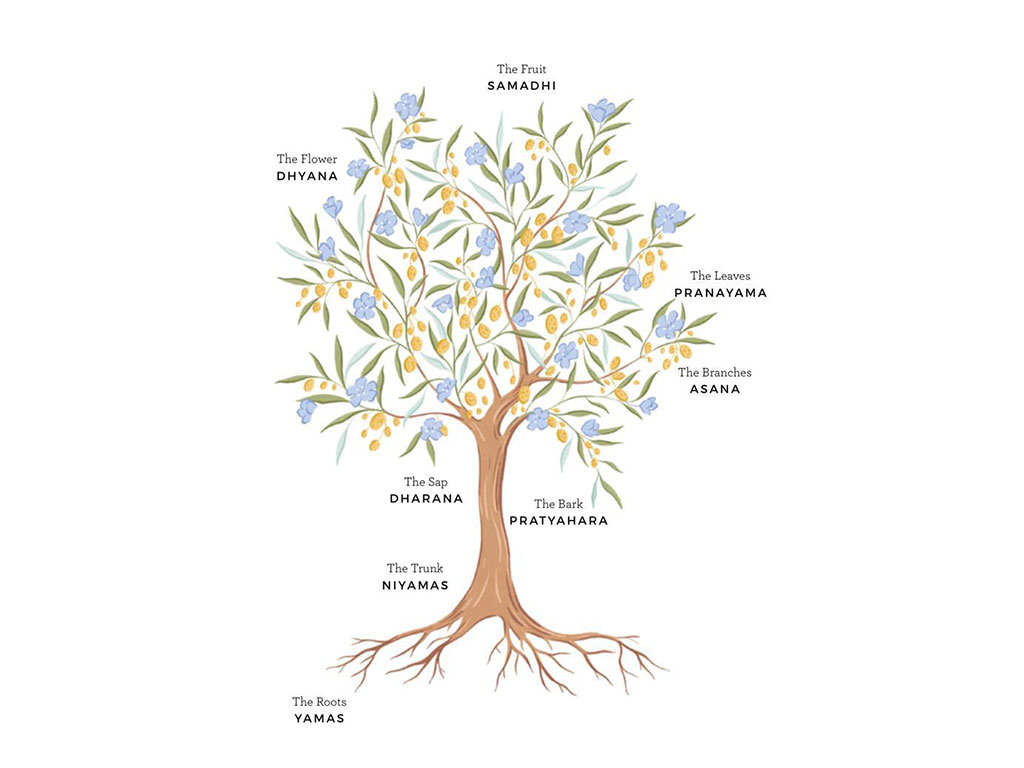17th November 2022
The Origins of Yoga: Part 2

Patañjali: The Father of Yoga As We Know It
The second part of my Origins of Yoga series, and the next crucial stage of the timeline – perhaps the most groundbreaking and transformative for yoga and its integration into society – focuses exclusively on Patañjali, known by some as the Father of Yoga.
Patañjali is the author of perhaps the most influential yoga book of all time, The Yoga Sūtras of Pantañjali. The book takes all yoga theory and practice knowledge from much older traditions and transforms them into a concise and easy to follow blueprint that would go on to change yoga into one of the pinnacles of wellness today.
It was believed that Patañjali lived between the 2nd and 4th centuries, and was an all knowing, masterful ancient sage who was born in Gonarda, a small village in Rajasthan, India. Other sources of his origin and life are very unclear and continue to be shrouded in urban myth, with some substantial beliefs hailing from the idea that he came from the heavens as a snake reincarnated, aligning with Hinduism’s great interest in the concept of one soul having many different physical lives and purposes.
Patañjali was believed to be an incredibly intelligent and knowledgeable sage, such that his understanding of the world spanned multiple fields where he had gained expert status. It was said he helped develop Ayurveda, or the ancient system of medicine, that he contributed greatly to the workings of the Sanskrit, the classical south asian language, and even to the foundations of mathematics and anthropology.
The Yoga Sūtras – the blueprint to life
‘Sūtra’ quite literally translates into ‘thread’ and can be thought of as an observation or, as I like to envision it, ‘piece of wisdom’. Patañjali sets out 196 of these observations in the book and they put forward yoga aims, practices, obstacles and the results that can be obtained. The results that many of us aim to arrive at during our life journey – purpose and freedom to name two.
In a nutshell, the Yoga Sūtras will help you live your life with more connection, intention, mindfulness and compassion.
For example, some of the Sūtras discuss the source of all suffering including the ego. Patañjali shares that the ego is essentially everything that blinds us from seeing our ‘True Self’ and this includes the so-called false perception of seeing the mind and body as the True Self. Patañjali went on to observe that there are five intrusive obstacles within our mind, which mask our true self and act as the source of all suffering.
These are known as the Kleshas.
- Avidya: A lack of awareness or ignorance
- Asmita: insecurity, feeling more or less than you really are
- Raga: too attached to the pleasurable parts of life
- Dvesa: resistance to things we do not like
- Abhinivesa: attachment to life and fearing death
These five obstacles are still so prominent in modern day life. Although we do not wish for them to be so, they seem hardwired in our brains because of how society has developed, as we have moved further and further away from understanding our True Self.
Even though these facets do not relate to the most popular interpretation of yoga, one would argue to be the asanas, or postures, you can see how simply being aware of these afflictions can guide us to be much more mindful in our daily actions and behaviours, and to change things for the better.
In fact, classical researchers viewed the Yoga Sūtras as more of a philosophical piece than anything, and an investigation into the relationship between spirit and matter. An account of the workings of the mind, to know what is true and how to know so, to understand the foundations of the Universe, and the meaning of life – salvation, in simple terms.
Some hypothesise that the Sūtras were similar to today’s Theory of Everything idea, that puts together how the universe was seemingly created and how we have come to know reality. Therefore, many people suggest that his work had a major hand in developing the common ideologies of life today. This stands as a testament to his importance, and the importance of the original creators of these ideas, and their vast base of knowledge and supreme understanding of the intricate mechanics of the human system, and life’s complexities.
And now, Yoga
Suitably, Patañjali starts his Yoga Sūtras first chapter with:
“Atha yoganusasanam”
Which can be translated into “now begins the instruction on the practice of Yoga” or to some “and now, yoga”.
Some believed that in this two-word inclusion Patañjali had said all he needed to, that these eight syllables were plenty to dispel all that came before yoga. In how we go about our lives in such frantic pursuit of happiness, meaning, freedom – those things are never achieved, and so the cycle never ends. Until we find ourselves with no other place to turn than to pursue yoga.
And this, in a way, was my experience. Yoga became so fundamental for me in recapturing the spark of life and becoming truly content with being exactly where I am, in this moment. Finding the beauty in all aspects of life.
Mapping out Yoga Sūtras’ ‘eight limbs’ and their significance to us today
When people first think of yoga, asana (the postures) is usually what comes to mind first. A beautiful backbend or serene Warrior II . Yoga is so much more than that. There are seven other limbs that Patañjali mapped out and which offer guidance on how to connect mind, body and spirit in order to life with freedom, meaning and purpose. These limbs are fundamental to expanding not just our expertise and skill within the physical practice of yoga but in expanding our consciousness and using yoga as a tool for self-development, and ultimately to facilitate understanding and mastery over the mind.
These eight limbs are:
- Yamas: moral disciplines or restraints
- Niyamas: self-disciplines or observances
- Asanas: the physical postures
- Pranayama: breathing techniques
- Pratyahara: withdrawing our senses from the external world and turning to enter the deep world within ourselves
- Dharana: concentration, which is the refined practice of stilling the crests of the waves the mind naturally throws to our consciousness, to observe thus our mind objectively in better preparation for meditation
- Dhyana: meditation and can be understood as simply ‘being’ and noticing our awareness as a factor of life. There are minimal thought processes hindering the flow of the mind as it stays in a steady, calm state of peace
- Samadhi: enlightenment. Samadhi translates to a oneness with all things, where euphoria exists as you become nothing and everything at the same time, and realise the divinity in the world around us. By doing this you raise your consciousness to a high level – Patañjali mentions this the ‘ultimate state’.
He wanted us to put this practice into our everyday lives and use it as a blueprint for how we go about our days. If you are interested to learn more, I go into more detail in my book Yoga Happy.
Patañjali wished for us to practice Sadhana daily, which is the understanding of our True Selves taken on through incorporating all of these elements. This can garner a self-awareness we never thought was achievable and will give us a newfound sense of wisdom that can be taken into all walks of life.
So what did Patanjali say about the end goal of pursuing life through these limbs?
“yogāṅgānuṣṭhānādaśuddhikṣaye jñānadīptirāvivekakhyāteḥ” (Sutra ii.28)
This can be translated to “Through the practice of the eight limbs of yoga, the distortions of individual perception are destroyed and the light of true wisdom brings clarity of consciousness” Such is its importance, it could refer to meta-physics as is now known today, as the science of our consciousness. Yoga goes so far beyond a physical exercise, that it can truly change our perceptions of life and inspire us to simply become more whole.
Why Patañjali’s teachings can be profound for you
The workings of Patañjali were designed to be able to be passed down through generations and have been interpreted in many different ways. He defined yoga as ‘Chitta Vritti Nirodha’ (sutra 1.2) which can be translated to “yoga is the removing of the fluctuations of the mind”.
We may go through life pursuing career success, financial freedom, achievements within sporting or general competitive domains, and define these goals as the things that have made our lives worthwhile and have been rewards for our endless graft and hard work. However, for Patañjali, it is necessary to realise a state of being outside of yourself. And if you truly dig deep, I think you will agree and realise that these “goals” are not what brings you freedom and happiness.
Outside of our ego, you are externalised from your entire existence and what it means to be you. This is where you realise the ultimate consciousness and that we are all one. Once you have uncovered the possibilities associated with this kind of state, you can pursue life’s many paths with a newfound sense of wonder, awe, and motivation to make the very most out of whichever direction you decide to embark upon.
Patañjali promotes the importance of pure awareness – of being here and now, with no attachments to the memory of the past, or to no imagination of the future. You can only truly accomplish magical things if you find your flow in the present moment. Otherwise, if you continue to be entrapped in tangles of thought patterns that shroud your past experiences and anticipation for what might happen in times ahead, you miss out on the freedom associated with awareness and power of now.
The sheer magnitude of yoga presents itself in the endless benefits that can arise from practicing on a regular basis. But this can seem overwhelming. I remember reading the Yoga Sūtras on my first teacher training and feeling out of my depth. So I went away and delved into some of the concepts and practices they share through other books and trainings. And then when I went back to read the Sūtras, I understood so much more and I learnt something new from them. My point being, it all takes time. It may be a cliche but this really is a journey and these fundamental parts of yoga will seep into your life and transform it in incredible ways.
STAY CONNECTED WITH ME
Subscribe to my newsletter to receive the latest news, updates and offerings.










